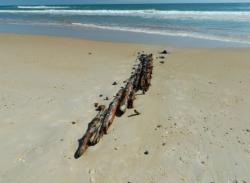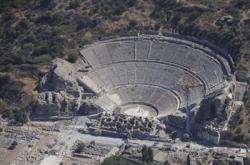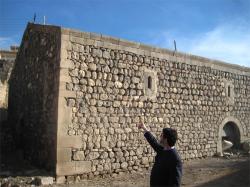INSTITUT SUPERIEUR D'ANTHROPOLOGIE
INSTITUTE OF ANTHROPOLOGY
ONLINE COURSES / COURS A DISTANCE
NEW OPEN COURSE : JANUARY 2013
HRM 104 : INTRODUCTION TO INTANGIBLE CULTURAL HERITAGE
REGISTER NOW
USA –  –Topsail Island - A piece of history unique to Surf City emerged on the beach when Hurricane Sandy skirted Topsail Island’s shore, drawing curious onlookers who are reminded to look, but not touch. A section of the William H. Sumner, a three-masted schooner whose young captain died under suspicious circumstances after running the ship aground in 1919, has been protruding from the sand a short distance from the Dolphin Street beach access. At least part of the 489-ton, 165-foot ship is believed to be resting at the bottom of the Atlantic Ocean near the southern end of the island. Erosion caused by strong coastal storms routinely exposes what has been identified as a side portion of the ship. A large frame of the ship that once rested on the shore is in the state archaeology lab in Fort Fisher.
–Topsail Island - A piece of history unique to Surf City emerged on the beach when Hurricane Sandy skirted Topsail Island’s shore, drawing curious onlookers who are reminded to look, but not touch. A section of the William H. Sumner, a three-masted schooner whose young captain died under suspicious circumstances after running the ship aground in 1919, has been protruding from the sand a short distance from the Dolphin Street beach access. At least part of the 489-ton, 165-foot ship is believed to be resting at the bottom of the Atlantic Ocean near the southern end of the island. Erosion caused by strong coastal storms routinely exposes what has been identified as a side portion of the ship. A large frame of the ship that once rested on the shore is in the state archaeology lab in Fort Fisher.
http://www.jdnews.com/news/local/piece-of-surf-city-history-emerges-after-sandy-1.48099
FRANCE –  La Mézière - En préliminaire a un lotissement au sud de la ville : les Lignes de la Gonzée, l'Inrap est intervenu pendant sept mois. Les fouilles viennent de prendre fin. Elles ont mis à jour des occupations au néolithique, à l'âge du bronze, à la période antique ou gallo-romaine et au Moyen Âge. De la période du V au VII e siècle, 600 tombes ont été mises à jour et fouillées. Françoise Le Boulanger, spécialiste à l'Inrap de la période précise « nous allons en post-fouille étudier les aménagements et reconstituer les objets recueillis. Dans les tombes du V e siècle nous avons découvert près de la tête d'un défunt une coupe en verre. Ce dépôt a peut-être été motivé par le passage de la civilisation païenne à la civilisation chrétienne. » Par ailleurs, dans les tombes du VII e , les archéologues ont découvert une céramique en pâte rouge et un petit flacon disposé au pied du défunt. « Un geste familial et personnel, précise Françoise Le Boulanger. C'est très inhabituel. » ;« Dans une bonne partie des 600 tombes diverses perles ont été trouvées : en verre, en ambre parfois en association avec des perles de couleur verte, bleue, noir ou jaune, incolore et même pelliculée en or, détaille Stéphane Blanchet, responsable de l'opération. Certaines ont pu servir de parures d'autres de décorations sur les vêtements. En tout cas c'est la première fois que l'on met à jour des perles en utilisation dans un conteste funéraire du V e siècle. » Lors des portes ouvertes, en juin, un sarcophage avait été présenté au public avec le squelette du défunt. Gérard Bazin, le maire, avait souhaité conserver un exemplaire. L'ensemble a été laissé en place trois semaines et enlevé de son emplacement d'origine par une pelleteuse, avant d'être acheminé enlieu sûr dans un local municipal. « Dans un proche avenir, le sarcophage va être consolidé, avant d'être exposé au public », conclut Guy Castel, conseiller délégué au patrimoine.
La Mézière - En préliminaire a un lotissement au sud de la ville : les Lignes de la Gonzée, l'Inrap est intervenu pendant sept mois. Les fouilles viennent de prendre fin. Elles ont mis à jour des occupations au néolithique, à l'âge du bronze, à la période antique ou gallo-romaine et au Moyen Âge. De la période du V au VII e siècle, 600 tombes ont été mises à jour et fouillées. Françoise Le Boulanger, spécialiste à l'Inrap de la période précise « nous allons en post-fouille étudier les aménagements et reconstituer les objets recueillis. Dans les tombes du V e siècle nous avons découvert près de la tête d'un défunt une coupe en verre. Ce dépôt a peut-être été motivé par le passage de la civilisation païenne à la civilisation chrétienne. » Par ailleurs, dans les tombes du VII e , les archéologues ont découvert une céramique en pâte rouge et un petit flacon disposé au pied du défunt. « Un geste familial et personnel, précise Françoise Le Boulanger. C'est très inhabituel. » ;« Dans une bonne partie des 600 tombes diverses perles ont été trouvées : en verre, en ambre parfois en association avec des perles de couleur verte, bleue, noir ou jaune, incolore et même pelliculée en or, détaille Stéphane Blanchet, responsable de l'opération. Certaines ont pu servir de parures d'autres de décorations sur les vêtements. En tout cas c'est la première fois que l'on met à jour des perles en utilisation dans un conteste funéraire du V e siècle. » Lors des portes ouvertes, en juin, un sarcophage avait été présenté au public avec le squelette du défunt. Gérard Bazin, le maire, avait souhaité conserver un exemplaire. L'ensemble a été laissé en place trois semaines et enlevé de son emplacement d'origine par une pelleteuse, avant d'être acheminé enlieu sûr dans un local municipal. « Dans un proche avenir, le sarcophage va être consolidé, avant d'être exposé au public », conclut Guy Castel, conseiller délégué au patrimoine.
http://www.ouest-france.fr/actu/actuLocale_-Archeologie-un-sarcophage-du-VII-e-siecle-preserve-_35059-avd-20121109-63960069_actuLocale.Htm
PAKISTAN - Au Pakistan, le patrimoine bouddhiste est menacé. Selon plusieurs dépêches, le pillage porte gravement atteinte à la préservation des vestiges. « Nous sommes confrontés à un sérieux problème, alerte le chef du département gouvernemental de l’archéologie et des musées, Fazal Dad Kakar, car c’est un vaste pays et nous avons peu de moyens. Nous manquons de ressources pour surveiller les centaines de sites bouddhiques, beaucoup étant situés dans des régions isolées. » Une grande partie se trouvent dans la vallée du Swat, au Nord-Ouest du pays, près de l’Afghanistan, où les pilleurs profitent de l’instabilité politique. L’art bouddhique du Gandhâra — autre nom de cette région — est célèbre dans le monde entier. Il s’est développé au carrefour d’influences indiennes, perses et hellénistiques, suite à l’expédition d’Alexandre le Grand en Asie Central au IVe siècle av. J.-C. C’est aussi dans cette région que s’est développé le bouddhisme mahayana, qui aura eu une influence décisive sur l’extrême Orient. C’est d’ailleurs une destination de premier choix pour la Chine.
http://www.lemondedesreligions.fr/actualite/menace-sur-l-archeologie-du-bouddhisme-au-pakistan-02-11-2012-2815_118.php
TURQUIE –  Ephèse - The Seljuk Municipality Assembly has approved a reconstruction and protection plan for the ancient city of Ephesus, an important step toward its bid for inclusion on the UNESCO World Heritage list. After the plan is put into effect, agricultural operations will continue in the field within the borders of the Ephesus 1st degree Archaeological Site. As the borders of the ancient city have been determined, new walking lanes will be created in the ancient city as well as new entrance gates and retail stores. The city’s importance as a commercial center declined as the harbor was slowly silted up by the Cayster River (Küçük Menderes). Ediz said they had been working to complete a project, called “Ephesus Reunion with the Sea.” Currently, the city’s distance is six kilometers from the sea. The ancient city is famous for the Temple of Artemis, one of the Seven Wonders of the Ancient World. Currently only on the temporary UNESCO World Heritage Site list, it was one of the seven churches of Asia cited in the Book of Revelation and the site of several fifth-century Christian councils, where the Gospel of John may have been written.
Ephèse - The Seljuk Municipality Assembly has approved a reconstruction and protection plan for the ancient city of Ephesus, an important step toward its bid for inclusion on the UNESCO World Heritage list. After the plan is put into effect, agricultural operations will continue in the field within the borders of the Ephesus 1st degree Archaeological Site. As the borders of the ancient city have been determined, new walking lanes will be created in the ancient city as well as new entrance gates and retail stores. The city’s importance as a commercial center declined as the harbor was slowly silted up by the Cayster River (Küçük Menderes). Ediz said they had been working to complete a project, called “Ephesus Reunion with the Sea.” Currently, the city’s distance is six kilometers from the sea. The ancient city is famous for the Temple of Artemis, one of the Seven Wonders of the Ancient World. Currently only on the temporary UNESCO World Heritage Site list, it was one of the seven churches of Asia cited in the Book of Revelation and the site of several fifth-century Christian councils, where the Gospel of John may have been written.
http://www.hurriyetdailynews.com/new-construction-plan-approved-for-ephesus.aspx?pageID=238&nID=34340&NewsCatID=375
IRAN –  Tabriz - Iran has started the reconstruction of the Armenian St. Hripsime Church after it was damaged by an earthquake this August in the North of Iran, reports Armenpress citing Atrpatakan Diocese of the Armenian Apostolic Church. The church is located in the north-western of Tabriz city and Archbishop Grigor Chifchian visited the reconstruction site, he told blahovest-info.ru. he said the Agency for Protection of Monuments of Iran will cover the expenses. According to archaeologists, the church was built in the place of another church, dating back to the 3rd century. Iran's Ministry of Culture included the church and the ruins of an old chapel St. Anerevuyt into a list of state protected objects and after the devastating earthquake, reconstruction works were immediately launched.
Tabriz - Iran has started the reconstruction of the Armenian St. Hripsime Church after it was damaged by an earthquake this August in the North of Iran, reports Armenpress citing Atrpatakan Diocese of the Armenian Apostolic Church. The church is located in the north-western of Tabriz city and Archbishop Grigor Chifchian visited the reconstruction site, he told blahovest-info.ru. he said the Agency for Protection of Monuments of Iran will cover the expenses. According to archaeologists, the church was built in the place of another church, dating back to the 3rd century. Iran's Ministry of Culture included the church and the ruins of an old chapel St. Anerevuyt into a list of state protected objects and after the devastating earthquake, reconstruction works were immediately launched.
http://armenpress.am/eng/news/699134/iran-reconstructs-armenian-church.html